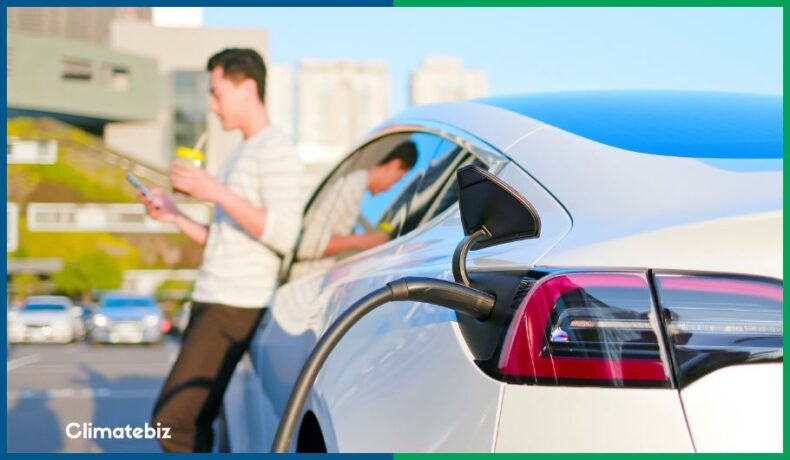One of the most frequently asked questions you may ask yourself before purchasing a Tesla (or any EV) is, “how long does it take to charge?”.
That’s understandable; after all, charging becomes a part of a Tesla owner’s daily routine, and knowing how long it takes to charge such a vehicle can be handy, especially when making plans.
Unfortunately, answering this question is not as simple as you may think, but we have taken a crack at it.
In this post, we discuss how long it takes to charge a Tesla.In addition, we provide the estimated charging times for each Tesla model using different charging methods.
Finally, we explain how you can calculate your EV’s charging time.
Table of Contents
How Long Does It Take To Charge A Tesla?
The following table highlights each Tesla Model’s estimated charging time. These times consider each model’s battery capacity and the different charging methods available.
Table 1. Charging From 0% to 100% State Of Charge:
| Charger | Model S | Model S Plaid | Model 3 Long Range | Model 3 Performance | Model 3 Standard Range | Model X | Model X Plaid | Model Y Long Range | Model Y Performance |
|---|---|---|---|---|---|---|---|---|---|
| Mobile Connector NEMA 5-15 (Level 1) | 135 h | 132 h | 119 h | 105 h | 91 h | 174 h | 167 h | 110 h | 101 h |
| Mobile Connector NEMA 5-20 (Level 1) | 101 h | 99 h | 90 h | 79 h | 68 h | 116 h | 111 h | 83 h | 76 h |
| Mobile Connector NEMA 6-15 (Level 2) | 58 h | 57 h | 33 h | 29 h | 25 h | 70 h | 67 h | 33 h | 30 h |
| Mobile Connector NEMA 6-20 (Level 2) | 37 h | 36 h | 24 h | 21 h | 18 h | 44 h | 42 h | 24 h | 22 h |
| Mobile Connector NEMA 10 – 30 and 14 – 30 (Level 2) | 24 h | 23 h | 16 h | 14 h | 12 h | 25 h | 24 h | 16 h | 14 h |
| Mobile Connector NEMA 14 – 50 and 6 – 50 (Level 2) | 18 h | 17 h | 12 h | 10.5 h | 9 h | 17 h | 17 h | 11 h | 10 h |
| Wall Connector | 11.9 h | 12 h | 8.1 h | 7.2 h | 6.2 h | 12 h | 11 h | 7.5 h | 7 h |
Note that for level 1 charging methods, charging times are over 100 hours. Don’t be alarmed by these numbers, as they express the estimated time it would take to charge the Tesla from 0% to 100%.
On a day-to-day basis, you wouldn’t charge your Tesla from 0% to 100% because you wouldn’t completely deplete the battery.
To improve performance, Tesla recommends maintaining your Tesla battery within the 20% to 90% state of charge range for daily use.
Table 2. Charging From 20% To 90% State Of Charge (As Recommended By Tesla)
| Charger | Model S | Model S Plaid | Model 3 Long Range | Model 3 Performance | Model 3 Standard Range | Model X | Model X Plaid | Model Y Long Range | Model Y Performance |
|---|---|---|---|---|---|---|---|---|---|
| Mobile Connector NEMA 5-15 (Level 1) | 84 h | 82 h | 74 h | 65 h | 56 h | 108 h | 104 h | 68 h | 63 h |
| Mobile Connector NEMA 5-20 (Level 1) | 63 h | 61 h | 56 h | 49 h | 42 h | 72 h | 69 h | 51 h | 47 h |
| Mobile Connector NEMA 6-15 (Level 2) | 36 h | 35 h | 20 h | 18 h | 16 h | 43 h | 42 h | 20 h | 19 h |
| Mobile Connector NEMA 6-20 (Level 2) | 23 h | 22 h | 15 h | 13 h | 11 h | 27 h | 26 h | 15 h | 14 h |
| Mobile Connector NEMA 10 – 30 and 14 – 30 (Level 2) | 15 h | 14 h | 10 h | 9 h | 7 h | 16 h | 15 h | 10 h | 9 h |
| Mobile Connector NEMA 14 – 50 and 6 – 50 (Level 2) | 11 h | 11 h | 7 h | 7 h | 6 h | 11 h | 11 h | 7 h | 6 h |
| Wall Connector | 7.4 h | 7.4 h | 5 h | 4.5 h | 3.8 h | 7.4 h | 6.8 h | 4.7 h | 4.3 h |
Table 3. Charging With A Tesla Supercharger (From 20% to 70% State Of Charge)
| Charger | Model S | Model 3 Standard Range | Model X | Model Y Long Range |
|---|---|---|---|---|
| Tesla Supercharger (charging from 20% to 70% = 50% of total range) | ≈ 30 minutes | ≈ 23 minutes | ≈ 30 minutes | ≈ 25 minutes |
Tesla recommends that owners only use DC Fast Charging (supercharging) when necessary, like during long road trips.
It’s important to point out that the tables above show rough estimations (calculated using the information on Tesla’s website) and that charging times vary due to several factors.
What Determines Tesla Charging Time?
Multiple factors influence a Tesla’s charging time. These include:
- Battery Capacity (according to your Tesla model)
- The current State of Charge (SoC) of your Tesla battery
- Internal and external temperature
- Charging Method / Charging Specs
With so many variables to consider, it can be hard to estimate how long it takes to charge your Tesla. Depending on your charging method, it can take anywhere from 30 minutes to 5 days.
Now, let’s discuss a bit further some of the factors that determine charging time.
Tesla Battery Capacity
Tesla chargers are rated the “miles of range” they can provide per hour of charging.
Therefore, to estimate your Tesla’s charging time, you need to know your EV’s battery capacity (in terms of range) and the range (in miles) your charger can provide per hour of charging.
Not all Tesla models have the same battery capacity. For this reason alone, it’s no surprise that different Tesla models will have different charging times.
Currently, Tesla offers four different models:
- Model S (and version Model S Plaid)
- Model 3 (versions: Long Range, Performance, and Standard Range Plus)
- Model X (and version Model X Plaid)
- Model Y (versions: Performance and Long Range)
Each model’s battery capacity differs and is rated by range, the estimated distance your Tesla can travel on a single charge.
Tesla owners can choose to display range as a percentage of the battery capacity or the number of miles it can be driven.
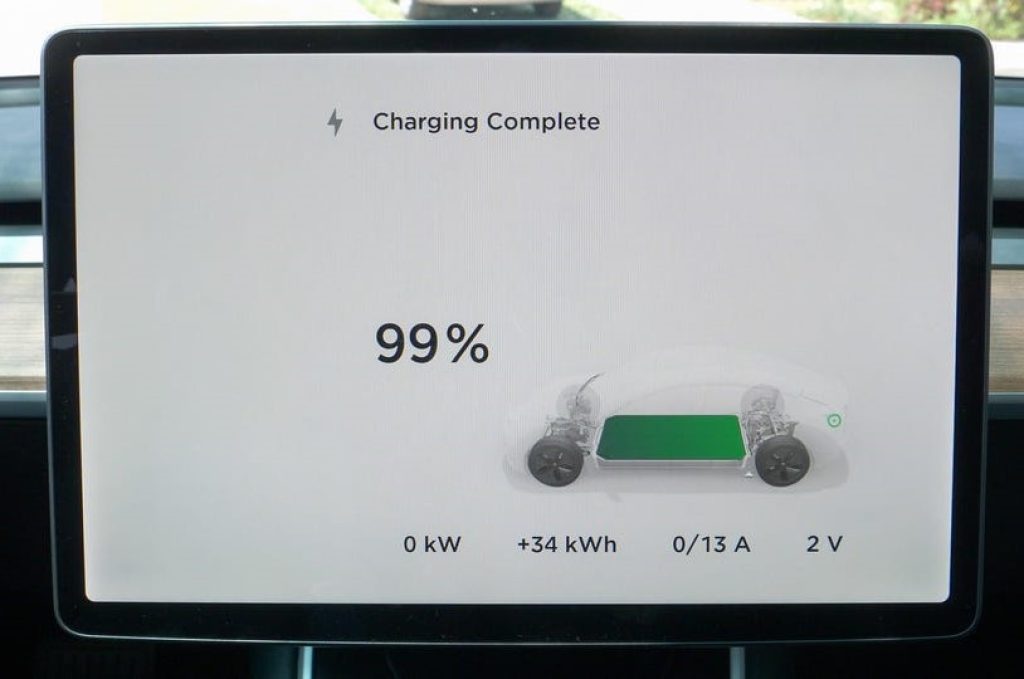
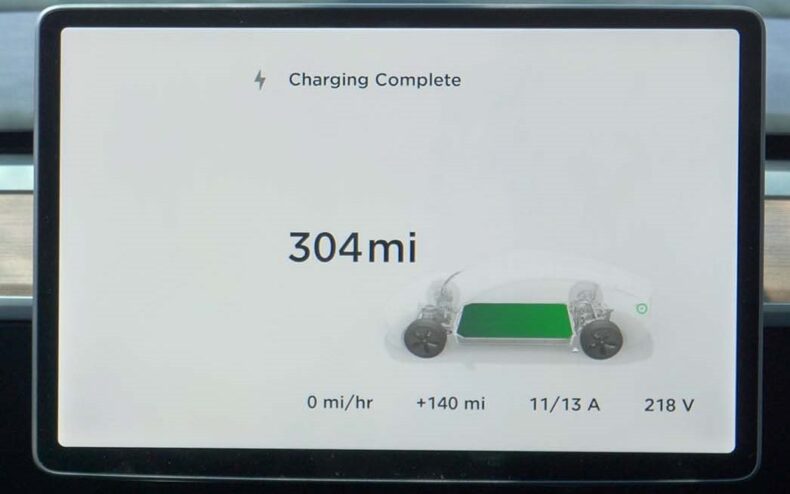
Source: motoringelectric.com
Here are the rated ranges of each Tesla model (and the different versions of each model), according to Tesla’s website:
Table 4. Rated Range (EPA est.) For Each Tesla Model
| Model and Version | Total Range (EPA est.) | Usable Range (20% to 90% SoC) |
|---|---|---|
| Model S | 405 mi / 652 km | 284 mi / 456 km |
| Model S Plaid | 396 mi / 637 km | 277 mi / 446 km |
| Model 3 Performance | 315 mi / 507 km | 221 mi / 355 km |
| Model 3 Long-Range AWD | 358 mi / 576 km | 251 mi / 403 km |
| Model 3 Standard Range Plus | 272 mi / 438 km | 190 mi / 306 km |
| Model X | 348 mi / 560 km | 244 mi / 392 km |
| Model X Plaid | 333 mi / 536 km | 233 mi / 375 km |
| Model Y Performance | 303 mi / 488 km | 212 mi / 341 km |
| Model Y Long Range | 330 mi / 531 km | 231 mi / 372 km |
*EPA (U.S. Environmental Protection Agency) rates the ranges
Later in this post, we use this information to explain how you can estimate the time it takes to charge your Tesla.
Please note: these are the “official” ranges for a brand-new Tesla battery. Battery capacity can decrease over time due to software updates, or because of everyday usage — batteries age, they tend to lose capacity (range) over time.
Moreover, cold weather can reduce the range by around 40%, while high temperatures can also negatively impact EV range.
Current State Of Charge (SoC)
When charging your Tesla battery (or any battery with a high capacity), you’ll notice that the charging rate is not constant throughout the charging process.
While many factors influence the charging rate, the primary ones include:
- The battery’s current state of charge (SoC);
- The use of fast charging; and
- Charging in extreme temperatures.
For now, let’s focus on the current state of charge — the level of charge relative to the battery’s total capacity — and how it impacts the charging rate.
Think of it like this: when a rechargeable battery is depleted, its internal resistance is low so that it can accept a higher charging current.
However, once the battery is almost full (reaches a high SoC), internal resistance increases and the battery can no longer accept high charging currents.
In fact, Tesla states on its website that “your vehicle charges faster when the battery is at a lower state of charge; charging slows down as the battery fills up.”
For this reason, charging from 80% to 100% SoC can take almost the same time as charging from 10% to 85% due to increased internal resistance (because the battery is almost full).
To circumvent this issue, Tesla recommends keeping your charging habits within the ‘daily’ range bracket, only charging to approximately 90% SoC and only charging to 100% when preparing for a longer trip.
Internal And External Temperature
Your battery’s temperature is another factor that significantly impacts charging time.
Rechargeable batteries are based on the principle of reversible chemical reactions. The rate at which these reversible reactions occur depends significantly on internal and external temperatures.
Freezing temperatures slow down these reactions, resulting in a longer charging time. Additionally, charging in hot temperatures can be slower due to increased internal resistance.
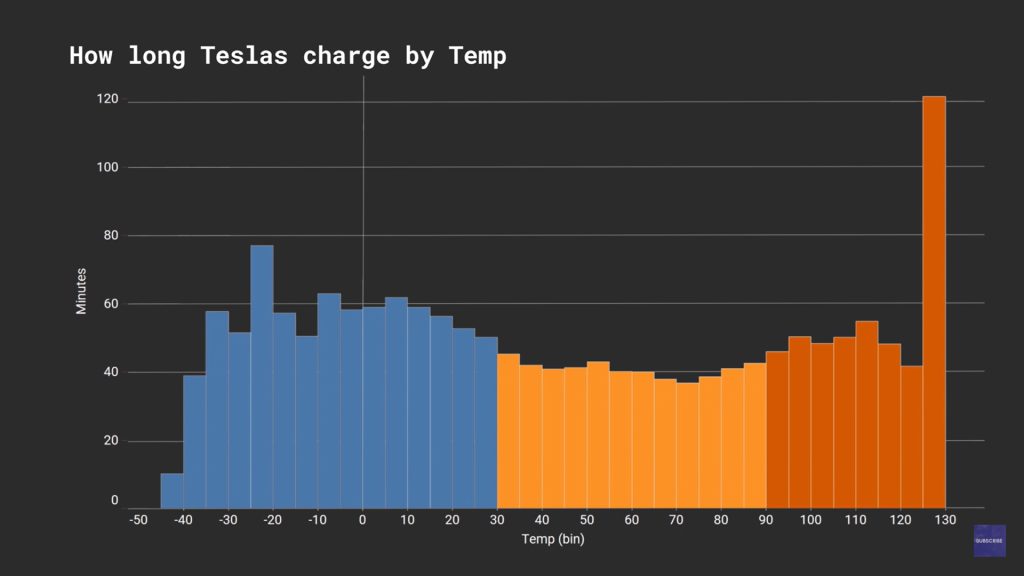
Source: tezlabapp
Therefore, batteries perform better at room temperature. More specifically, Tesla batteries function optimally within a temperature range of 60ºF (~16°C) to 80ºF (~27°C).
To minimize these temperature-related issues, a Tesla owner can precondition their vehicle’s battery temperature to allow for a faster charging process (when using Tesla’s supercharging method). Still, the preconditioning process can take some time on its own.
So keep in mind that charging temperature will inevitably impact charging speed.
Charging Method
The charging method you choose dictates how long it will take to charge your Tesla.
Why? Because each charging method provides a specific charging power (power = voltage x current), and the higher the charging power, the shorter the charging time.
Essentially, Tesla offers three charging methods:
- Level 1: charges at 120 V, AC power
- Level 2: charges at 240 V, AC power
- Supercharger: charges at ~480 V, DC fast charging
You can charge your Tesla at home using level 1 or 2 chargers. Tesla superchargers, however, are “on the road” solutions located at public stations.
Charging Your Tesla At Home
To charge your Tesla at home, you have the following options:
- Using a mobile connector (with different NEMA adapters available)
- With a corded mobile connector (can’t change the NEMA plug)
- Installing a wall connector
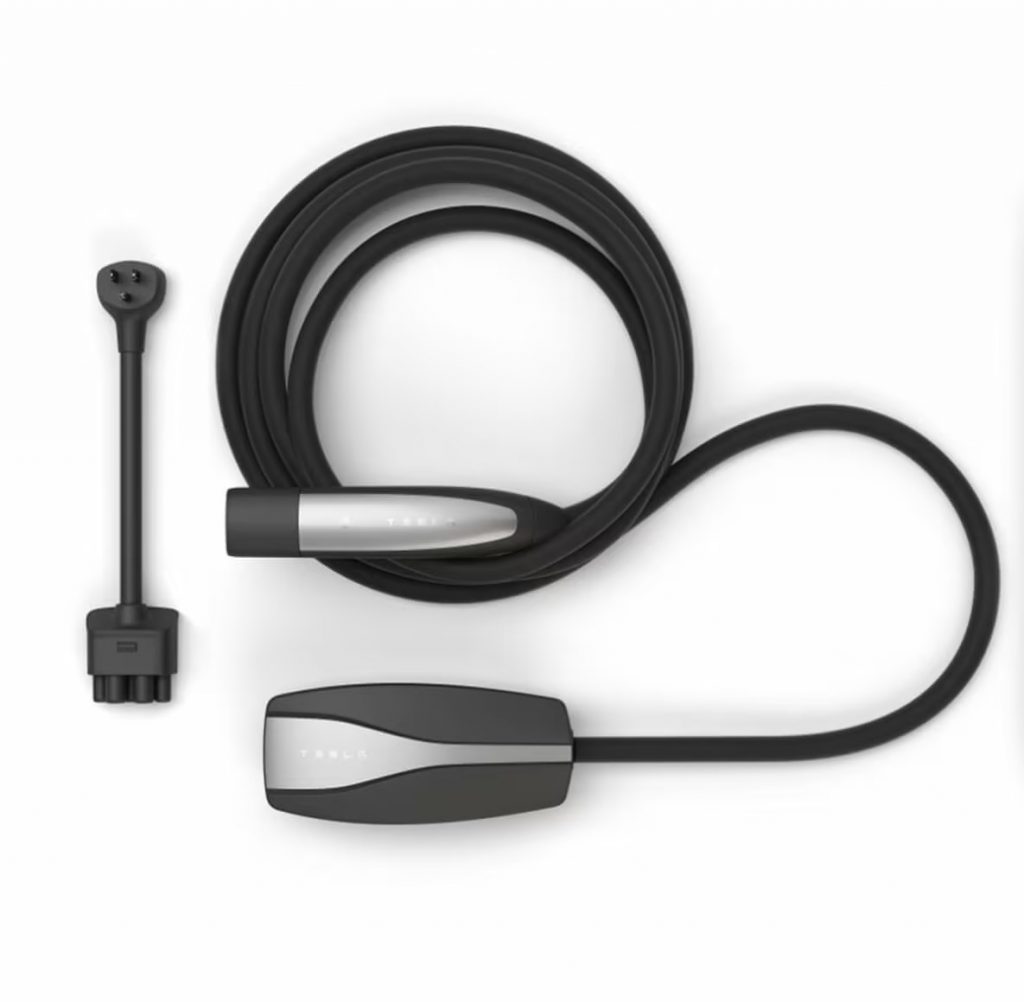

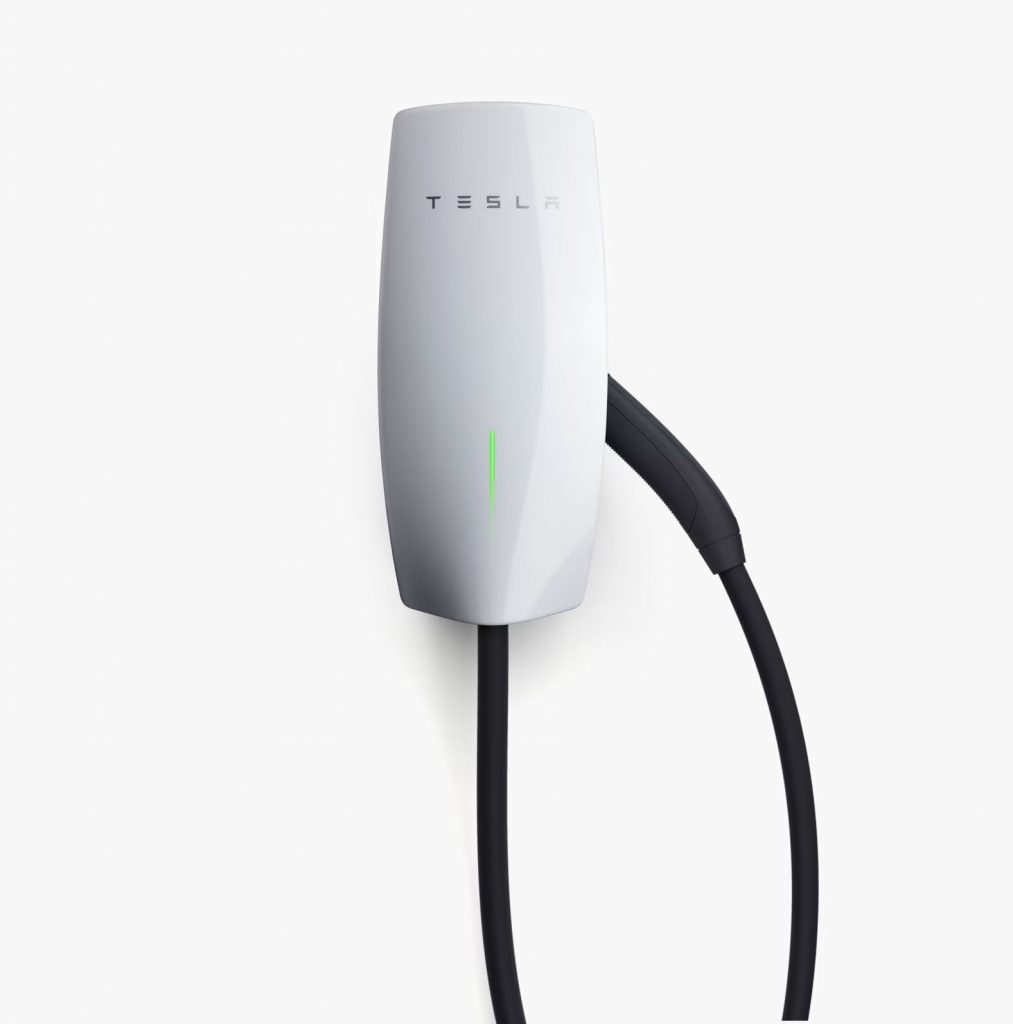
Each charger delivers specific charging power, and essentially, the charging power determines the charging time.
Charging Specs
As previously mentioned, the charging power significantly impacts the charging time.
Power is given by:
Power (W) = Voltage (V) x Current (A)
Therefore, when providing the same charging current, a level 2 charging method will charge faster than a level 1 method because it allows for a higher charging power.
Let’s say both chargers provide a current of 12A. In this case:
Level 1 (120 V): Power (W) = 120 V x 12 A = 1440 W = 1.44 kW
Level 2 (240 V): Power (W) = 240 V x 12 A = 2880 W = 2.88 kW
If we consider 1 kW ≈ 4 mi/hour of charging, then the 120V 15A charger would charge at a rate of 5.7 mi/h while the 240V 15A charger would charge at a rate of 11.52 mi/h.
So, after one hour of charging, a level 2 charger will have added double the range of a level 1 charger. (when providing the same amount of current).
You House’s Electrical System
Your home’s electrical system determines the level of charger you’ll use. If your home has wall outlets supplying 240V of voltage, you’re in luck — you can use a level 2 charger.
However, if your electrical system can only provide 120V, you must stick to a level 1 charger.
What About Amperage?
Different outlets provide different currents.
For instance, the standard 120V wall outlet (NEMA 5 – 15) connects to a 15A breaker, but because the usable amount of current is only 80%, you can pull up to 12A from this outlet. If you try to pull more amps than that, the breaker will trip.
But suppose your house’s electric system offers different breakers. In this case, your home has various wall outlets — such as NEMA 5 – 20 (120V 20A), NEMA 14-30 (240V 30A), and NEMA 14 – 50 (240V 50A) — then the current provided will vary from the standard 12A, and you’ll be able to charge your Tesla with higher charging power.
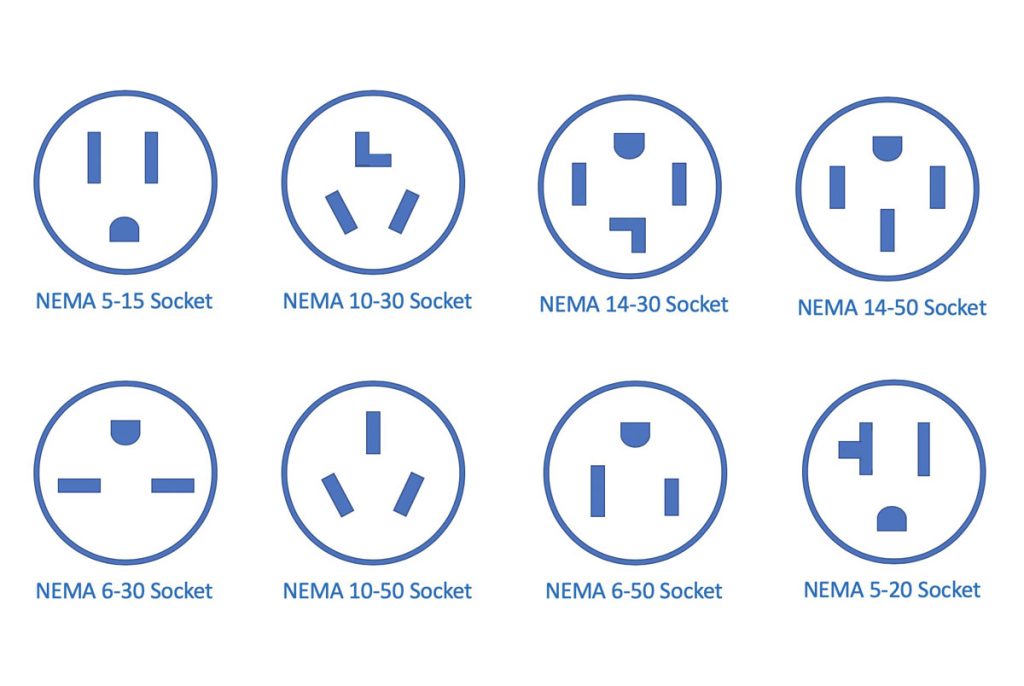
Source: splitvolt.com
To connect your mobile charger to these different wall outlets, you’ll have to use the appropriate NEMA adapter.
Thankfully, Tesla offers a variety of NEMA adapters.
NEMA Adapters

Source: shop.tesla.com
Tesla Wall Connector
Apart from the mobile connector, which you simply plug into a wall outlet, the Tesla wall connector connects directly to your house’s electric panel.
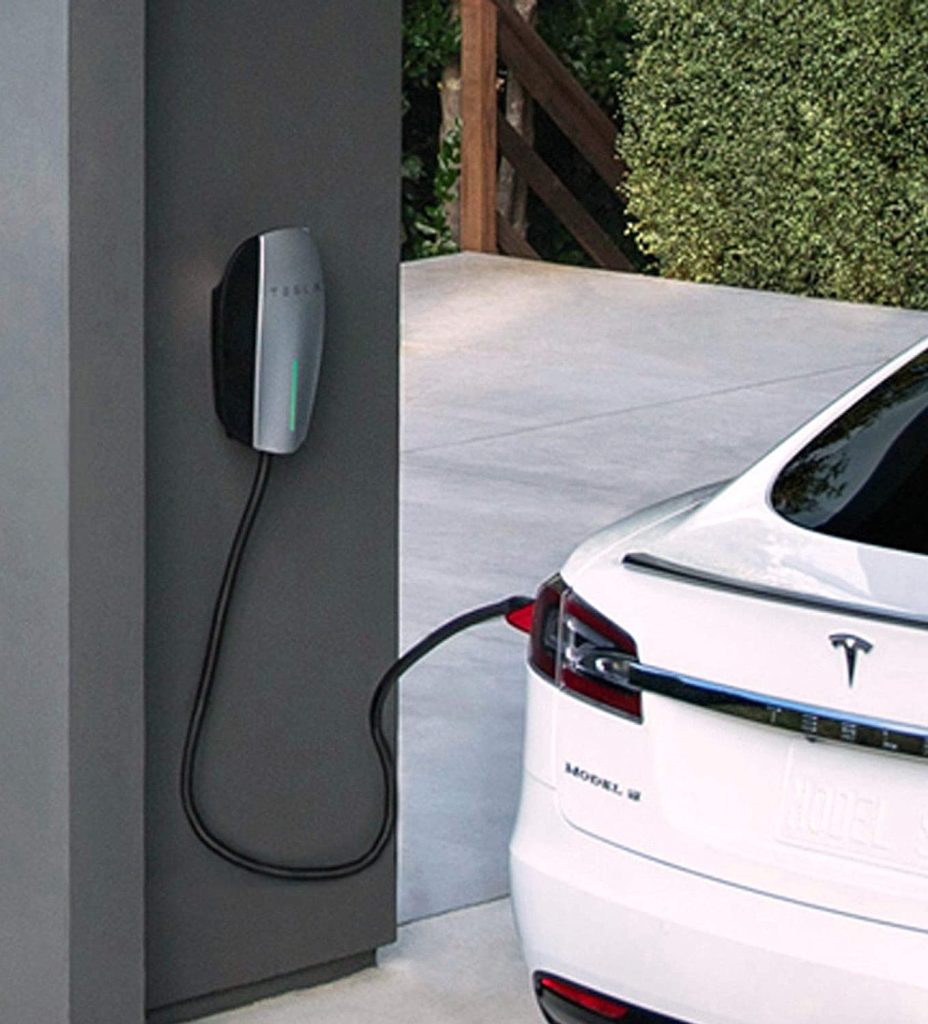
Not only does it look great in your garage, but it is also a much faster-charging option since it can provide more power (240V and up to 48 A).
Table 5. Maximum Mileage Added By A Wall Connector, For Each Tesla Model
| Circuit Breaker | Maximum Output (80% of usable amps) | Power at 240 V (volts x amps) | Model S (≈3.6 mi added per kW) | Model 3* (≈3.9 mi added per kW) | Model X (≈3.1 mi added per kW) | Model Y (≈3.9 mi added per kW) |
|---|---|---|---|---|---|---|
| 60 A | 48 A | 11.5 kW | 41 mi/h | 44 mi/h | 35 mi/h | 44 mi/h |
| 50 A | 40 A | 9.6 kW | 34 mi/h | 37 mi/h | 29 mi/h | 37 mi/h |
| 40 A | 32 A | 7.7 kW | 27 mi/h | 30 mi/h | 23 mi/h | 30 mi/h |
| 30 A | 24 A | 5.7 kW | 21 mi/h | 22 mi/h | 17 mi/h | 22 mi/h |
| 20 A | 16 A | 3.8 kW | 14 mi/h | 15 mi/h | 12 mi/h | 15 mi/h |
| 15 A | 12 A | 2.8 kW | 10 mi/h | 11 mi/h | 9 mi/h | 11 mi/h |
Source: tesla.com
Charging Limit For Each Tesla Charging Method
The charging speed (expressed in miles per hour added to your Tesla battery) depends on your EVs battery and your charging method.
Tesla’s website states the maximum charging speed that each charging method (each NEMA adapter) can provide for each Tesla model.
Using this information, we prepared the following table:
Table 6. Charging Speed Provided By Different NEMA adapters (For Each Tesla Model)
| Charging Method | Max. Power output | Model S range added per hour of charging | Model 3 range added per hour of charging | Model X range added per hour of charging | Model Y range added per hour of charging |
|---|---|---|---|---|---|
| NEMA 5 – 15 | 120V x 12A = 1,44kW | 3 mi/h 4.8 km/h | 3 mi/h 4.8 km/h | 2 mi/h 3.2 km/h | 3 mi/h 4.8 km/h |
| NEMA 5 – 20 | 120V x 16A = 1,92kW | 4 mi/h 6.4 km/h | 4 mi/h 6.4 km/h | 3 mi/h 4.8 km/h | 4 mi/h 6.4 km/h |
| NEMA 6 – 15 | 240V x 12A = 2,88 kW | 7 mi/h 11.2 km/h | 11 mi/h 17.7 km/h | 5 mi/h 8.0 km/h | 10 mi/h 16.1 km/h |
| NEMA 6 – 20 | 240V x 16A = 3,84 kW | 11 mi/h 17.7 km/h | 15 mi/h 24.1 km/h | 8 mi/h 12.9 km/h | 14 mi/h 22.5 km/h |
| NEMA 10 – 30 and 14 – 30 | 240V x 24A = 5,76 kW | 17 mi/h 27.4 km | 22 mi/h 35.4 km/h | 14 mi/h 22.5 km/h | 21 mi/h 33.8 km/h |
| NEMA 14 – 50 and 6 – 50 | 240V x 40A = 9,60 kW | 23 mi/h 37.0 km/h | 30 mi/h 48.2 km/h | 20 mi/h 32.2 km/h | 29 mi/h 46.7 km/h |
This information is crucial for estimating your Tesla’s charging time.
How To Calculate Tesla Charging Time?
To calculate Tesla charging time you only need to know:
- Your Tesla’s rated battery capacity
- Your Tesla model’s charging limit, according to the charging method you use
Example 1: Charging a Tesla Model S Using A Wall Connector
For this first example, let’s consider the Model S.
In table 4, you’ll see that the rated range of the Model S is 405 miles. This number expresses how many miles you can drive on a single charge (from 100% to 0% SoC).
Now let’s assume you’ll charge your Model S using a Wall connector (wired to a 60 A circuit breaker) — table 5 shows that the maximum charging speed for the Model S using this wall connector is 34 mi/h.
With these two pieces of information, you can calculate the estimated charging time like so:
Estimated Charging Time (h) = Battery Rated Capacity (mi) / Max. Charging Speed (mi/h)
Estimated Charging Time (h) = 405 mi / 34 mi/h = 11.9 hours
In conclusion charging a Tesla Model S from 0% to 100% SoC, using a wall connector (wired to a 60 A breaker) would take approximately 12 hours.
Example 2: Charging A Tesla Model Y Using A Mobile Connector With A NEMA 6 – 20 Adapter
The rated range of the Model Y is 303 miles and the maximum charging speed, using a NEMA 6 – 20 adapter, is 14 mi/h.
That’s all the info you need to calculate the estimated charging time. Let’s calculate:
Estimated Charging Time (h) = Battery Rated Capacity (mi) / Max. Charging Speed (mi/h)
Estimated Charging Time (h) = 303 mi / 14 mi/h = 21.6 hours
In conclusion, charging a Tesla Model Y from 0% to 100% SoC, using a mobile connector plugged into a NEMA 6 – 20 socket would take approximately 22 hours
You can apply the same logic to estimate the time it would take to charge your Tesla.
Please note: it’s imperative to note that these are simple estimations. As previously stated, several factors can impact charging time, such as temperature, the current state of charge, the age of the battery, etc.
Can A Tesla Charge In 30 Minutes?
Yes, a Tesla can be charged in 30 minutes via a Supercharger (DC fast charging).
This charging method uses direct current to charge the battery directly (so there’s no need to convert AC to DC). For this reason, it can charge at a high voltage of up to 480V.

Source: businessinsider.com
However, this can only be achieved under certain conditions.
For instance, you first have to precondition your battery for fast charging because your battery pack needs to be warm to accept such a high charging power.
More importantly, it does not apply to charging your Tesla from 0% to 100% SoC, which can take about 2 hours using a supercharger.
This “charging a Tesla in 30 minutes” scenario is only valid for charging between 20% to 70% SoC.
In fact, when plugging into a Supercharger, your vehicle’s charge limit may be automatically decreased to 80% because the last 20% can take the same amount of time (if not more) as charging from 10% to 80% SoC.
This happens because when your battery is almost full, the internal resistance increases dramatically, and your battery struggles to accept a charge.
So, in summary, you can charge your Tesla in 30 minutes, but you wouldn’t be adding 100% of your battery capacity (actually doing so is not recommended for daily use).
In reality, a supercharger can add about 50% of the total range capacity in 30 minutes (ideally from 20% to 70% SoC).
Final Thoughts
Tesla charging times can vary from 30 minutes to 5 days, depending on several factors, such as battery size, the type of charger being used, the power source, etc.
Level 1 chargers (120 V) can take a long time (a matter of days, not hours) to charge a Tesla fully. It can be a working option for those who don’t travel long distances very often and leave their Tesla plugged in overnight.
However, if you need a faster charging solution, level 2 charging is the way to go. It provides a higher charging power, charging your Tesla much faster than any level 1 charger.
The third option is going to a Supercharging Station, which can recharge your battery in less than an hour. However, Tesla recommends only using this charging option when necessary (such as during long road trips), as frequent use can decrease battery capacity and shorten battery life.
Now that you’ve done your research and know your charging options — and how long each one takes to charge your Tesla — you should be good to go!

